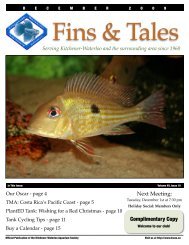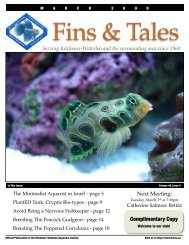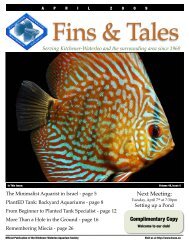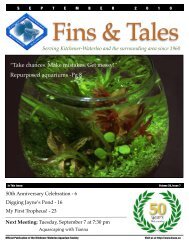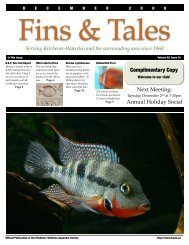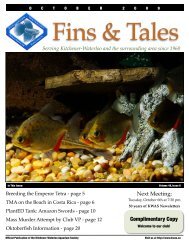June 2009 - Kitchener Waterloo Aquarium Society
June 2009 - Kitchener Waterloo Aquarium Society
June 2009 - Kitchener Waterloo Aquarium Society
You also want an ePaper? Increase the reach of your titles
YUMPU automatically turns print PDFs into web optimized ePapers that Google loves.
J U N E 2 0 0 9<br />
May Name That Fish<br />
Submitted by Zenin Skomorowski, KWAS (zenin@golden.net).<br />
Melanotaenia praecox - Photo by Zenin<br />
This month’s first “Name That Fish” guessing game featured<br />
three Dwarf Neon Rainbows Melanotaenia praecox. They were<br />
donated by Jerry Draper from the Tropical Fish Room in<br />
Brantford and won by Jamie McDougall.<br />
The origin of Dwarf Neon Rainbows is New Guinea in South<br />
East Asia. Commercial farms now produce most of the stock<br />
found in the retail stores. These fish have a silver grey body<br />
with a shimmering blue metallic sheen. Their fins are red, and<br />
like all Rainbowfish, have two dorsal fins. The females are<br />
usually a bit smaller and have less intense colours. On the<br />
males, the first dorsal fin overlaps the second. Reproduction is<br />
by scattering sticky eggs. The young are very small for a long<br />
time, so be careful when doing water changes. The water<br />
should be soft and have pH of around 7.0 for reproduction, but<br />
they will live in a wide range of pH and water hardness. They<br />
are an omnivore, which means they eat pretty well anything<br />
from flake foods and small pellets to live and frozen foods.<br />
Orange Calico Pleco - Photo by Kathleen Gallagher<br />
range of 5.8 to 7.2 for breeding, but they will live happily in the<br />
8.2 pH of <strong>Kitchener</strong> tap water. Softer water is appreciated, so<br />
add some rainwater. A male will encourage a female to lay her<br />
eggs in his lair, that could be a rock cave or a hollow part of<br />
bogwood. After fertilizing the eggs, the male will chase away<br />
the female and tend to the eggs himself. He will protect the fry<br />
for quite a while until they use up the egg sack and venture out<br />
on their own. Blanched vegetables, algae wafers and algae<br />
growing in the aquarium makes up their diet. Plants will not<br />
be eaten.<br />
These plecos are good community fish with tetras, pencil fish,<br />
livebearers, and most barbs, but avoid the larger aggressive<br />
cichlids as tank mates.<br />
The Dwarf Neon Rainbow should be kept in groups of 5 or<br />
more. They are an excellent addition to a small, peaceful<br />
community aquarium since they rarely get larger than 5 cm ( 2<br />
inches ).<br />
This month’s second “Name That Fish” featured two Orange<br />
Calico bristle nose plecos. They were won by Terry Clements.<br />
These dwarf plecos originally came from tributaries of the<br />
Amazon in South America. They are readily bred by local<br />
hobbyists. These plecos are also known as the Red Marble or<br />
the Orange Marble bristle nose. They are all in the genus<br />
Ancistrus, but no specific collecting location or breeding<br />
information is available.<br />
A good aquarium setup would have some bogwood for them to<br />
rasp on, and a few hiding places. Water pH should be in the<br />
Terry Clements won the second name that fish. Unfortunately we didn’t<br />
get a photo of Jamie McDougall and his new Rainbows.<br />
23





